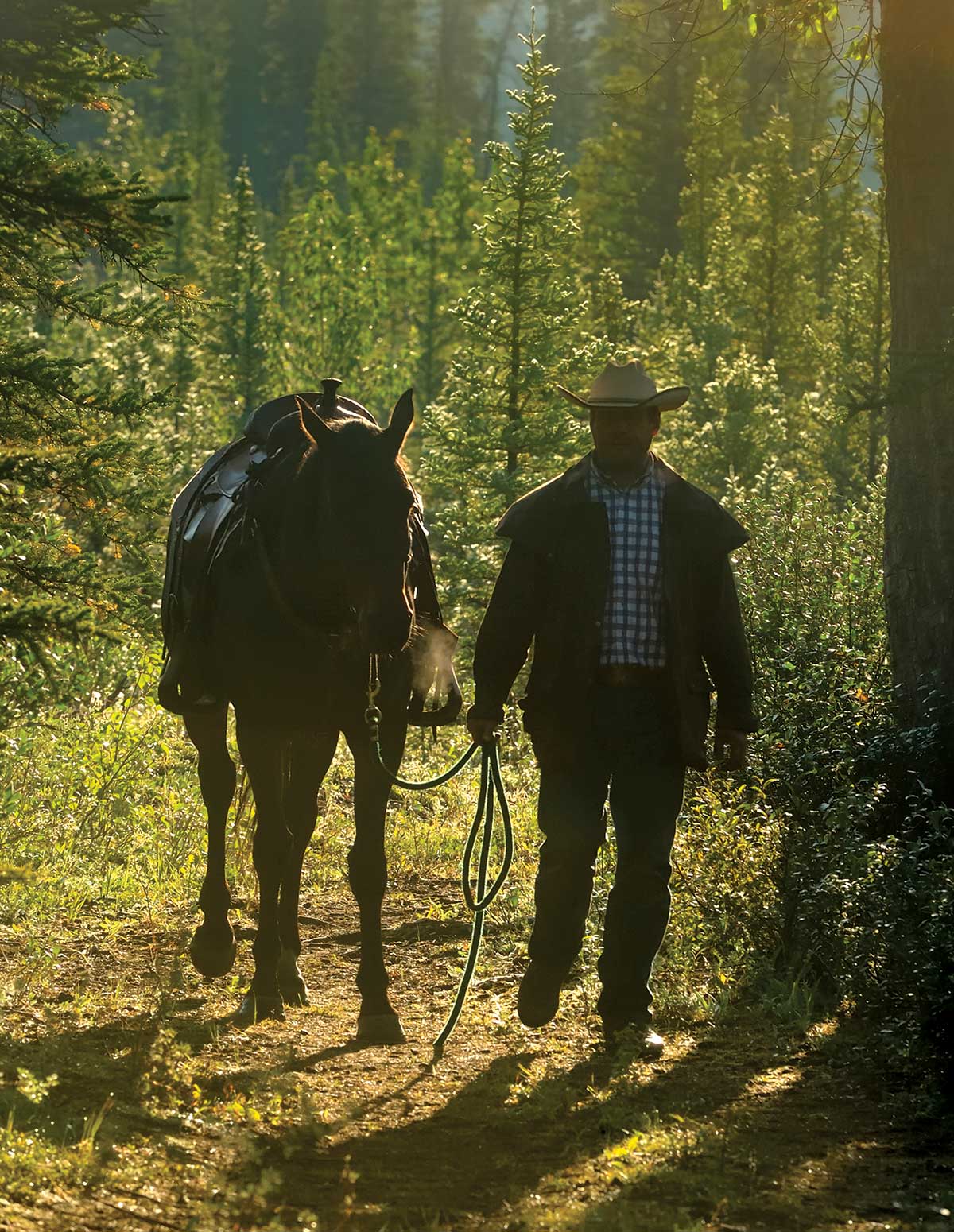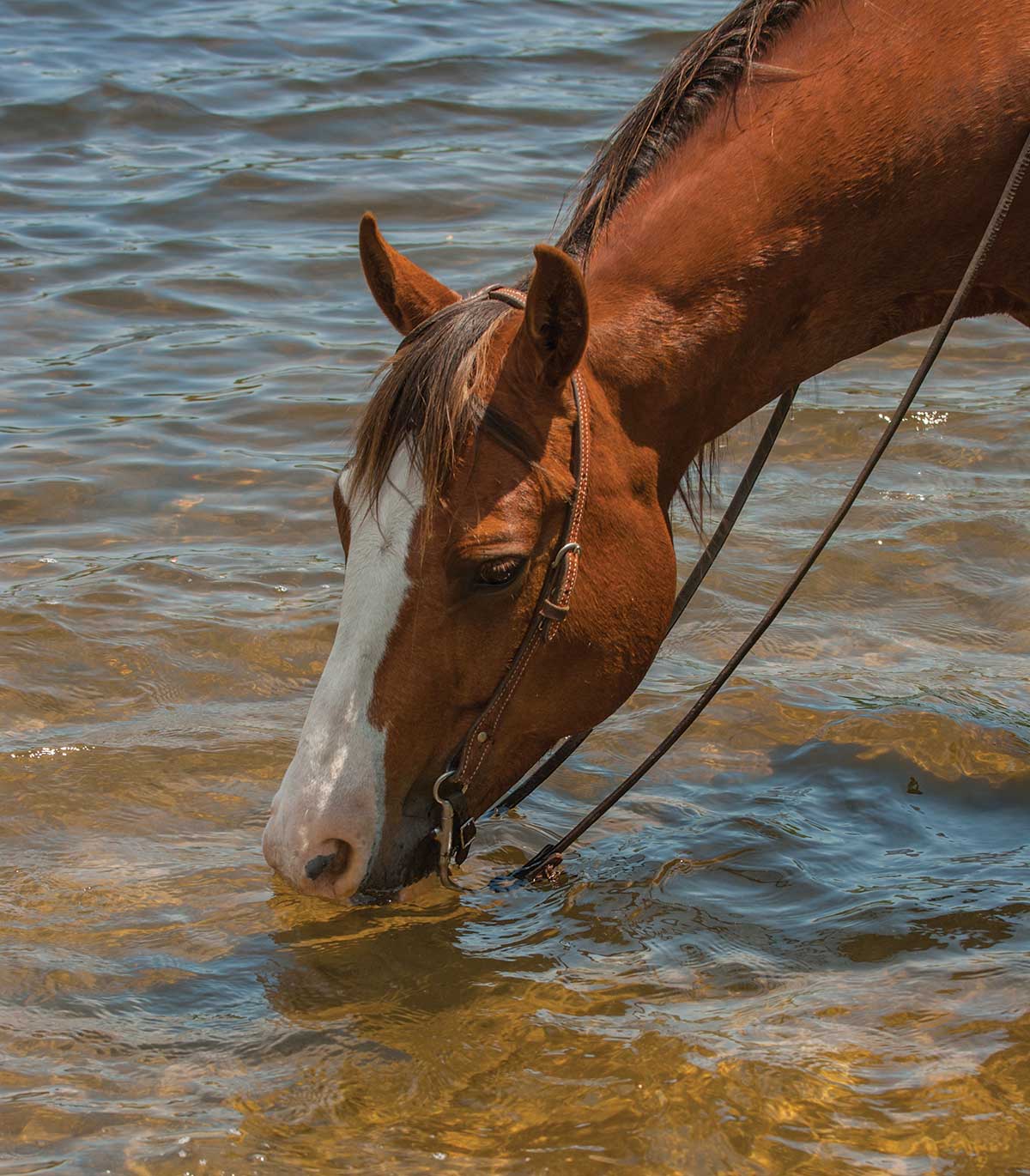
You can save your horse’s life by being prepared to handle trail riding emergencies until you get him to a veterinarian. You must know what to do in case of emergency if your riding adventures take you far from help.
[READ: Trail Riding Fitness for Yourself]
Here I’ll tell you what to do to prepare for an emergency before you leave on a ride, including what to pack in your saddlebag and on your person. Then I’ll share what to do in a crisis. Next, I’ll give you guidelines to handle six emergency situations until you can get your horse to a vet. I’ll also give you an emergency toolkit, and tell you what to do if your horse is stuck in a perilous situation or suffers a catastrophic injury. (Note: In any equine emergency, call a veterinarian as soon as you have service, and follow his or her instructions.)
Emergency Prep
You can decrease the chance you’ll have a trail emergency by being well prepared for your ride. Here are key preparation steps to take before you leave the barn and as you set out on your trail adventure.
Train your horse. Several months before your trip, train your horse to build his trust in you, so he’ll remain calm and trusting in challenging situations. Work on his ground manners. Teach him to stand tied. Train him to calmly pony another horse and be ponied from another horse. Practice trailer loading in varied conditions so you can get him to a vet quickly. (For training help, go to HorseandRider.com.)
Schedule a veterinary exam. Make sure your horse is healthy and able to tackle your planned trails, and ask your vet for any medications you might need to help relieve pain until you can get help.
Condition your horse. Prepare him for the type of trail riding you plan to do. (For a conditioning routine, go to HorseandRider.com.) If you’ll be riding in high altitudes, give him at least 24 hours to adjust once you arrive at your base camp.
[READ ABOUT: Trail Riding Conditioning]
Plan to ride with others. On long rides over rugged terrain or on overnight adventures, ride with at least one other person. It’s always safer to ride with someone, especially if you’re on a green or unknown horse or in new terrain.
Select the right riding buddy. Find a trail-riding buddy who’s knowledgeable and seasoned and has a calm, trail-savvy mount. If you can, ride regularly with this team to ensure that the horses are compatible in terms of personality and speed. On challenging trails, such as extreme desert or mountain terrain, consider
hiring a guide—either a professional guide or a local horseman who’s familiar with the trails and conditions.
Take vital signs. Learn how to take your horse’s vital signs—heart rate, temperature, respiration, gum color, capillary-refill time, and gut sounds. Once you have a baseline, you’ll know how much he’s deviating from normal if he suffers an injury or illness.
[READ: How to Take Your Horse’s Vital Signs]
Compile veterinary resources. Carry your veterinarian’s contact information, and compile a contact list of local vets in the area where you’ll be riding. (For a list of veterinarians who are members of the American Association of Equine Practitioners, visit aaep.org, and click on Get-a-DVM.)
Know the terrain. Lessen the chance for a surprise cliff, a washed-out trail, or other hazard by knowing the terrain. Talk with riders familiar with the area, park rangers, members of trail-club groups, and members of the local Back Country Horsemen of America chapter to ensure that your planned route is something you and your horse can handle. Train your horse to handle terrain challenges, and shoe him for those conditions or invest in trail-ready hoof boots.
[READ: Safely Negotiate Tricky Trail Terrain]

Plan for weather conditions. Study the weather, and prepare for sudden weather changes. Though the day may be warm and pleasant when you start out, a sudden thundershower or cold sleet can thoroughly chill you and your horse. Temperatures may also change drastically after sundown. In high altitudes, it might be sunny in the morning and raining or snowing by afternoon. Wear layers: Use a cotton base layer to absorb sweat, then add insulating layers. Pack a full-length waterproof duster that’ll cover you, your saddle, and your horse’s hindquarters in rainy conditions. Add a waterproof slicker if you need a lighter layer or to cover emergency supplies if you need to treat your horse in a rainstorm.
Plan to keep warm. If you’re cold, you’ll be less able to help your injured or ill horse. Pack matches in a waterproof container to build a fire to keep you warm and create smoke for visibility in case a rescuer needs to find you. Pack a candle stub to start a fire in windy, wet weather. On frigid days, put small, disposable hand-warmers in your gloves or boots. Stash a couple of Mylar space blankets in your saddlebag to cover your horse if he ties up or goes into shock.
Plan your route. Use trail maps and online information to plan your route. Find topographical maps that show altitude gain. Plan to be back at the trailhead or horse camp before dark, allowing for lunch breaks and detours. Let a trusted horseperson know where you’re going and when you’ll be back. Give this person your cell number, your vet’s number, and notes about what to do if you’re not back as planned. Leave a note in a plastic zip-close bag on your truck windshield with your route, time you left, time you expect to be back, and your contact information.
[READ: Use These Apps to Help Plan Your Trail Ride]
Know where you are. As you head out, note landmarks and places you could meet a responder to help you. Keep track of where you are on the trail map so you can tell someone the most direct route to find you in case of emergency. Know where any water sources are so you can help keep your horse hydrated in case you’re stuck for hours. You can also soak a hurt leg in a stream to reduce swelling.
Trust your horse. Trust your horse’s instincts. He might refuse to cross a stream or obstacle because he senses a danger you’re overlooking. If you become lost or disoriented, note that a horse will almost always go back toward home or to where you started the ride if you allow him to make directional decisions.
TRAIL-EMERGENCY TOOLKIT
Here are supplies to take with you on backcountry rides in case of emergency. Carry your cellphone and emergency items on your person, in case you and your horse part ways. Carry other items in your saddlebags.
Vital Signs
• Digital equine thermometer
• Stethoscope
First-Aid
• Antiseptic (Betadine scrub)
• Antibiotic ointment
• Self-adherent bandage
• 4-by-4-inch sterile gauze pads
• Gauze rolls
• Cotton quilts
Hoof Care
• Pliers
• Rasp
• Hoof boot
Other Supplies
• Duct tape
• Halter and lead rope
• Multipurpose tool
• Sharp pocketknife
• Small fold-up saw
•Wire cutters
Emergency Protocol
If an equine emergency occurs despite your best efforts, follow this protocol.
Stay calm. Don’t compound the problem by overreacting. Take deep breaths. Remind yourself that your horse’s health and well-being (and yours) rest on your ability to stay calm, safe, and take appropriate action.
Examine your horse. Approach your horse calmly. Speak to him in soothing tones, and stroke his neck to calm him. Assess the injury or illness, and determine your best course of action.
Take emergency steps. Take immediate action if your horse has suffered a wound or is colicking or tying up. (For how to do so, keep reading.) Apply common-sense first-aid. Stop the bleeding. Remove the stick from a puncture wound.
Assess the situation. Decide whether you should slowly ride, walk, or pony your horse to your trailer or leave him with your riding buddy and ride his or her horse to get help. (If you’re alone, tie your horse safely and walk out for help.)

On-Trail Treatment
Here’s how to handle six trail emergencies until you can get your horse to a veterinarian for care.
[READ: Equine Wound-Care Guide]
Leg wound/cut heel. Stop the bleeding by applying pressure. Pressure is key to halting blood loss and safer than a tourniquet. Then rinse the wound with water or a saline solution, wash with Betadine scrub, and apply an antibiotic ointment. To dress the wound, pack pieces of rolled up 4-by-4-inch sterile gauze pads against it. Then apply a nonstick cotton-wool material to absorb drainage and pad the wound. Finally, apply a self-adherent bandage. Slowly lead your horse to the trailhead, and call a vet as soon as you have service.
Laceration/puncture wound. This is a common injury. Your horse might fall off a trail or fall down; injure a leg going over a log; or spook, rear up, and fall over. First, use a sharp pocketknife or small saw to extricate your horse from brush, if needed. If he’s bleeding significantly, apply a pressure bandage (such as sterile gauze pads) or apply direct pressure to the wound. After you stop the bleeding, remove any foreign material from the wound the best you can (and keep it in your saddlebag for your vet’s inspection), wash and dress the wound as described previously, and lead him slowly along the trail back to your trailer or to get help. Call a vet as soon as you have service.
Wire/barbed-wire injury. If your horse gets tangled in a snarl of wire that was hidden in the bushes or tall grass, carefully cut the wire with wire-cutters to free him. Wash and dress the wound, and head back to the trailhead.
EMERGENCY RESCUE!
If your horse is stuck in a perilous situation—such as at the bottom of a cliff or in mud—or has suffered a catastrophic injury, call 911 immediately to get help from trained emergency responders who’ll work with a large-animal rescue team specifically trained to extricate horses and provide transport to the nearest veterinary hospital.
Colic. Colic (abdominal pain) can be life threatening for horses, so take immediate action. Symptoms include kicking at the belly, looking at or biting the belly or flank, refusing to drink, grunting or groaning, pawing the ground, rolling or thrashing when down (indicating severe pain), and gut changes (including excessive gas production, abnormal gut sounds, and no gut sounds at all.) If you suspect your horse is colicking, and your vet has prescribed Banamine for colic, give it to your horse as directed to relieve pain. Note that Banamine doesn’t treat colic—and can mask colic symptoms—so get your horse medical help immediately. If you’re far from the trailhead, your only treatment option might be to walk out to a place where you can trailer out. As soon as you’re in cellphone range, call a vet for professional advice. Note that indigestion, gas pain, and intestinal spasms might resolve after walking a few miles; still, call a vet immediately to ensure that the colic episode has completely resolved.
Tying up. Your trail horse’s muscles might cramp painfully due to heat stress, dehydration, electrolyte imbalances, or energy depletion. Symptoms include muscle cramping, severe muscle pain, elevated heart rate, tail swishing, and moving away from touch. If your horse ties up on a ride, don’t make him move. Give him a dose of Banamine to relieve pain, and cover the afflicted area with a space blanket to ease cramps. Offer water. When the cramps ease, walk him very slowly back to the trailhead, resting every half hour. Call a vet as soon as you have service.
Lost shoe. A loose or lost shoe can hurt your horse’s foot. If a shoe comes loose, file the clinches with a rasp, slowly and carefully work the shoe off with pliers, then apply a temporary hoof boot. If you ride or lead your horse with a suddenly bare foot, he can damage the hoof wall or bruise the sole in rocky terrain. If you don’t have a hoof boot, walk your horse home so there’s less stress on his bare foot. In a pinch, use duct tape to create padding on the bottom of his foot until you get to the trailhead.







